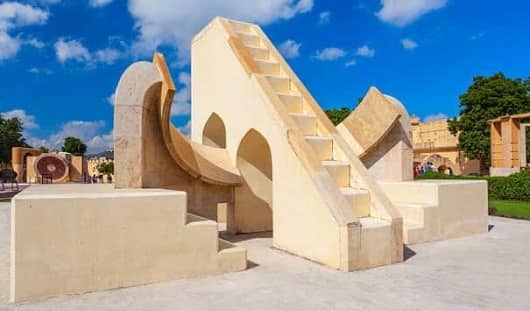Jantar Mantar is a major tourist attraction located in old Jaipur city, Rajasthan. It lies between Hawa Mahal and City Palace. Every year people in large numbers come to this place to witness the historical significance and beauty of this place. Due to its amazing popularity, this remarkable monument is ranked to be the top tourist destination in all over India.
The term Jantar Mantar is derived from Sanskrit. This entire term is a combination of two Sanskrit words “Jantar” and “Mantar”. Jantar word is originated from the Sanskrit word “Yantra” that implies machine or instrument. The word “Mantar” is derived from a Sanskrit word “Mantra” that implies calculation or consultation. Thus, the meaning of the entire term Jantar Mantar means “Calculation of instruments”.
There are several other popular attractions such as the Hawa Mahal, and City Palace that lies close to this place. If you are planning to visit this place, then you must definitely need to know some of the interesting facts about this monument that makes this place all the more exciting.

Interesting facts
1. This monument is a fabulous compilation of 19 architectural astronomical structures and 17 substructures that were developed by the famous King of Rajput “Sawai Jai Singh II”. He was the founder of this mesmerizing monument and was himself a brilliant astronomer.
2. Another important interesting fact about this monument is that the foundation of Jantar Mantar was laid in the year 1718 AD and it continued for a total time span of 20 years. The entire construction of the monument got completed in the year 1738 AD.
3. The primary objective of constructing this grand historical astrological monument was for the compilation of astronomical tables. It helped in the prediction of the movement and time of the sun, the earth and planets. Using this amazing astronomical tables, people at that time were easily able to predict the occurrence of lunar and solar eclipses.
By timing the earth’s revolution around the sun, they were able to track the location of stars as well. Other important discoveries were to determine the declination of different planets and defining the ephemerides and celestial altitudes.
4. The 19 astonishing structures of Jantar Mantar enabled observers to calculate the position of astrological entities with their naked eye. Due to which Jantar Mantar was considered as a benchmark consolidation of science and religion of that era.
5. The major reason for the development of Jantar Mantar was the heated discussion that happened between Sawai Jai Singh ll and the famous Mughal Ruler Muhammad Shah Zafar in the year 1718 AD.
The entire argument was related to the calculation of the fortunate date when the Mughal Emperor could begin his journey. This led to the creation of Jantar Mantar observatories at five places in the world. These were Delhi, Ujjain, Jaipur, Varanasi, and Mathura.
6. Yantras or structures present in the observatory were constructed out of stone masonry. Limestone was used to plaster them so as to protect their external appearance and give an appealing touch to them.
Some of those instruments got developed with the help of marble and later polished to offer the finest accuracy and finishing. Certain areas of the structures got built by the help of astronomical metal-based scales. They were later filled with the lead element to provide accurate calculations.
7. Jantar Mantar has been recognized with the status of “World Heritage Site” by UNESCO. This monument is safeguarded and maintained by “Archaeological Survey”, a reputed survey body in India.
8. Out of the five different Jantar Mantar observatories located in different parts of the world, the one that is located in Jaipur is considered to be the largest one. It is also the best-preserved observatories out of all of them.
The Samrat Yantra sundial is considered to be is the largest sundial in the whole world. This sundial has a height of around twenty-seven meters. Accuracy is one of the most important reasons behind the enormous size of Samrat Yantra. It is interesting to know that this sundial offers remarkable precision of up to three seconds. Isn’t it spectacular?
9. For the construction of this brilliant historic monument, an amount of 1,00000 to 1,50,000 INR was spent in the 18th century.
10. You must not be aware of the different names and functions of the structures listed in Jantar Mantar Jaipur
There are fifteen structures present in the observatory, each of them is made to offer distinctive functions to people
- The first one on our list is Samrat or Brihat Yantra that was built to tell day or night time
- Sasthamsa Yantra is the second structure that helped in the calculation of the distance of Sun and Zenith
- Jai Prakash Yantra and Small Ram Yantra helped in observation of night time
- Dhruva Darsaka Yantra is another great structure to show the location of the pole star
- Nadivalaya Yantra helped in the observation of solar time
- Horizontal Sundial and Laghu Samrat Yantra assisted in observation of time
- Krantivritta Yantra was built to work as Torquetum
- Krantivritta ll Yantra helped in the measurement of celestial longitude and latitude
- Daleshinottara Bhitti Yantra used to calculate the height of celestial objects
- Yantra Raj helped in the measurement of altitude, declination on longitude, local time, and Zenith distance
- Chakra Yantra calculated declination of heavenly objects
- Digamsa Yantra was made to find out Zimuth’s angle
- Unnathamsa Yantra and Rasivalaya Yantra were used to calculate the height of celestial bodies
- Kapala Yantra was another brilliant structure that helped in the calculation of local time and sun’s coordinates
- Disha Yantra was used to figure out the direction of celestial bodies at any given point of time.
Learning about these interesting facts about Jantar Mantar must have increased your enthusiasm to visit this phenomenal place. If you are heading to Jaipur city for a holiday trip, then along with Jantar Mantar you must plan to visit other nearby places like the Hawa Mahal and City Palace in the old Jaipur city.
An excursion through these great monuments will be a unique lifetime experience of witnessing solid geometry and a united astronomical system built to inquire the heavens.
Santosh Kumar, the author behind IndiasStuffs.com, is passionate about sharing valuable insights on a variety of topics, including lifestyle, technology, and Indian culture.

